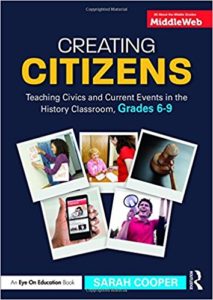The Day After: How Do We Teach Now?
A MiddleWeb Blog
When looking back at the MiddleWeb article I wrote the day after the election in 2016, I’m struck by how shocked my students and I were.
In 2020, during this twilight time as the nation determines a presidential winner, I’m feeling not so much shock as the need to shore up my teaching and once again dig into difficult topics.
The five tips from my 2016 post still apply:
- Keep talking about current events, relentlessly.
- Keep discussing civics and Constitutional issues.
- Keep relating then to now.
- Connect history to service.
- Give students unforgettable visuals of changemakers.
We did 1 through 3 in my first-period class today – the day after the election – and we’ll move into 4 and 5 during second semester with a reformers project I love.
Listening to Students
Happily, today was the day for our weekly current events presentations, in which three or four students present a summary of a news article, explain why they chose it, and field questions from their classmates.
These weekly discussions have translated better than I had hoped to online teaching. During the Q&A, I mute myself while the presenter calls on classmates who have written “question” or “comment” in the Zoom chat. Their give-and-take feels pretty similar to a physical classroom, though without the laughter over a zany science article or the physical tensing up that can come with a controversial subject.
This morning I started class after finding a few stories and maps to explain when and how the election might proceed from here. We did our usual daily chat. Then I asked the four presenters which of them had chosen a piece on the election. Three of them had, and so I said I’d save providing any additional information until after they finished.
It turned out that I couldn’t have scaffolded the stories better myself. (They were all from the New York Times, largely because our library provides a subscription to all students and staff.)
- Can Biden Still Win? Can Trump Still Win? Yes. Here are the Remaining Paths
- As Counting Begins, a Flood of Mail Ballots Complicates Vote Tallies
- What Happens If the Election Results Are Contested?
Once the students presented and answered questions, I pulled out electoral college maps from the Wall Street Journal and New York Times. Two students who hadn’t presented shared county-by-county maps they had found, showing the range of political views across states that seem monolithic only on the state electoral college map.
The eighth graders’ interest in potential court battles inspired me during our mid-class break to grab a History Channel video on the 2000 election, helping us layer history onto current events and examine more about why the popular and electoral votes can be different.
For the last 15 minutes of class, I introduced a new “What the Constitution Means to Me” project – open ended and, I hope, full of student choice and voice.
Three New Tips
So what would I add to the tips I gave myself on the day after the election in 2016?
Explain, don’t opine. As a history colleague who teaches AP U.S. Government wisely wrote to our faculty this morning: “It’s important that we set aside time to process our feelings with other adults so that we can be stable and centered when talking about the news with students. Most of them will have adults at home whose feelings they will be taking on; we should be in a different category.”
Remember how lucky we are to be history and civics teachers. This is my twenty-second year of teaching middle school history, and it never gets old. We have teachable moments every single day, especially now. By immersing ourselves in this work for the long haul, helping create the next generation’s citizens, we can make connections and find meaning.
Listen to my students. That said, this generation’s citizens are well on their way to being formed without any influence from me. Today’s ideal current events selections illustrate how much I learn from students’ curiosity every day. Even in a pandemic. Even in the quiet of the Zoom room. And especially during an election.

Browse Sarah’s many articles and reviews for MiddeWeb here. For other writing about history and more, visit her blog.



































